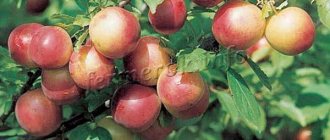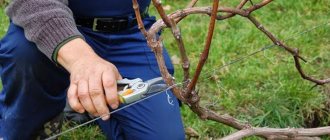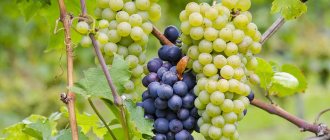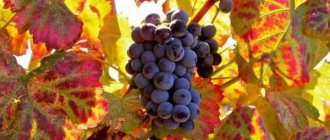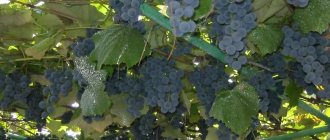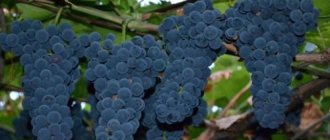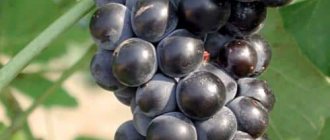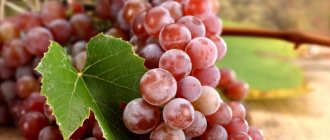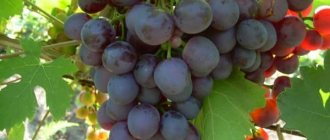Early grape varieties
The ripening period of early varieties is 100–110 days . They are grown in the south and north of Russia, as well as in the middle zone. Summer residents value early grapes for their early fruiting - the first harvest is harvested at the end of July or beginning of August.
In terms of taste and commercial qualities, they do not differ from mid-season or late varieties: the fruits are suitable for processing, preservation, fresh consumption, transportation and sale. When planting early-ripening grapes, it is important to pay attention to the composition of the soil and the space allocated for the plant.
Helios
This early-ripening table variety is frost-resistant and is rarely affected by fungal and viral diseases, which is why it is grown in all regions of the country. The bushes are medium-sized, the leaves are large, and there is slight pubescence on the surface of the plate. The flowers are bisexual, so the yield does not depend on weather conditions and pollinating insects.
The clusters are dense, conical, weighing about 500 g. The berries are large, obtuse-ovate, pink in color. The pulp is dense and juicy, the taste is sweet-nutmeg, the juice is colorless. Tasting rating of fresh fruits - 9 points. Helios grapes are grown for personal use and sale.
Early TSHA
The universal variety ripens in 100–110 days, is easy to care for, and is widespread in all regions of Russia. The bushes are medium-sized, the vine is strong and elastic, there is slight pubescence. The clusters are cylindrical-conical in shape, weighing about 75 g, of medium density. The berries are round, blue-black in color. The skin is medium thick and has a waxy coating. The yield of the variety is about 3.5 kg per bush per season. Juice and wine are prepared from grapes, the berries are consumed fresh or dried for the winter.
Russian early
Early Russian ripens in 105–115 days. The plant is tall and requires staking to trellises. Frost resistance of the variety is down to -23°C. The berries ripen smoothly and do not fall off or crack. The clusters are cylindrical, with a sharp tip, medium density, weight per one - 300-500 g. The berries are round-oval, weigh 8-10 g, the flesh is dense and crispy. The taste is sweet, with a pleasant aftertaste and rich aroma.
Early Russian is a fast-growing variety - summer residents collect the first harvest 3-4 years after planting. The grapes are resistant to mildew and powdery mildew, and are rarely damaged by wasps and spider mites. It is unpretentious in cultivation, the fruits are suitable for fresh consumption.
Classification of crops by ripening time
Depending on its origin, the grapevine is divided into 2 phenotypes - southern and northern. The first is characterized by the presence of unformed seeds in ripe fruits. The second is distinguished by the rapid formation of sweet berries in a short time and the bush’s full readiness for wintering. The ripening period for early ripening varieties is calculated from the moment the buds open. On this basis they distinguish:
- very early grape varieties - begin to bear fruit in 105 - 115 days;
- early forms - fruits ripen in 115-125 days.
Breeders have also bred very early species that produce a harvest in 85-95 days.
Extra early varieties of white grapes
The ripening period of very early varieties is 90–105 days. White grapes are valued for their tasty pulp, thin skin, and lack of seeds. For planting, it is recommended to choose early-fruiting and self-fertile varieties that rarely get sick and are frost-resistant.
Bazhena
Harvest in the first ten days of August. The bushes are lush, of medium height, and look original on the site. The flowers are bisexual, the leaves are medium dark green. The clusters are large, weighing 500–700 g, dense, cylindrical or conical in shape. The berries are elongated-ovoid, average weight - 13 g, yellow-green color, thin transparent skin. The taste is harmonious and sweet.
Bazhena is valued for its immunity to mildew and rapid and friendly ripening of shoots. The berries are eaten fresh or used in the preparation of desserts, drinks, baked goods, and winter preparations.
Hercules
The Hercules variety, popular in the middle zone and northern regions, is frost-resistant - it can withstand temperatures down to -35°C. The plant is medium-sized, the flowers are bisexual. Ripening period is 95–105 days. The clusters are conical, loose, weigh 500–800 g, some specimens reach 1 kg. The berries are large, round, pinkish-pale or yellow. The skin is medium thick, the flesh is juicy and tender, the taste is sweet. The berries are transportable and can be stored for up to 1 month after harvesting.
Attention! To increase productivity, summer residents form grapevines, that is, they give the plant the desired shape. There are several ways to form bushes, the most common and universal are multi-arm fan or cordon.
Rusbol
The ripening period for Rusbol table grapes is 110 days. The bushes are medium-sized, the inflorescences on the shoots appear early. The fruiting period is extended - summer residents harvest within 2-3 weeks. The variety is frost-resistant down to -25°C, and is immune to mildew and rot. Rusbol does not need shelter for the winter, which makes caring for it easier. The clusters are large, weighing 400–600 g, the berries grow close to each other. The fruits are oval, white, the flesh is dense and fleshy. The taste is pleasant, sugary, without bitterness or sourness. Productivity - up to 10 kg per plant.
Rusbol brushes do not attract insects, including wasps and slugs. One of the advantages is the fruitfulness of the eyes - each produces a shoot on which large and juicy berries ripen. It is recommended to consume the crop fresh.
Reviews
Planting grapes in the Moscow region is a thankless task, there is a lot of hassle, and the harvests are weak. It was like that before! Now choose, I don’t want to. My first experience was Jupiter, then Crystal, the third was the Beauty of the North. All are developing perfectly, they are ripening on time, the hands are fully ripened. My bushes are already mature, I don’t cover any of them for the winter.
In the Moscow region, it is better to plant grapes in the spring (after return frosts), so that the seedlings more or less take root before autumn. I have been growing northern Saperavi for about 9 years, I let it grow around the gazebo, its beauty is indescribable. Now I’m just selecting another variety, looking at it from the canteens. Preventive treatments are mandatory; I spray twice before flowering, in mid-summer and after harvest.
The earliest varieties of pink grapes
Pink grapes attract summer residents with their appearance - vines with berries will decorate any garden. The taste of the fruit is sweet and harmonious, its purpose is universal. Pink varieties are grown throughout Russia.
Gurzuf pink
The bushes are medium-sized, the leaves are medium-sized, slightly dissected. The vine ripens quickly. The clusters are cylindrical, winged, weigh up to 250 g. The berries are round, white-pink in color, with red streaks. The skin is dense, the flesh is juicy and fleshy. The taste is sweet, with a nutmeg aroma.
Gurzuf pink is recommended for the North Caucasus region, resistant to oidium, mildew and gray rot. Frost resistance - down to -25°C. The tasting score for wine made from berries is 8 points. The harvest is harvested in early or mid-August, used for transportation or sale, consumed fresh or made into wine.
Transfiguration
Super early table grapes ripen 105–110 days from planting. The bushes are medium in size, the buds bloom quickly, the vines are elastic, the flowers are bisexual. The weight of the bunch is about 800 g, the shape is cylindrical. The berries are pink, with a red tint, juicy and sweet. The pulp is dense, contains 2-3 seeds, the juice is colorless. Tasting score: 8.5 points.
To increase productivity, it is recommended to cover the Transfiguration for the winter, and during the flowering period, apply a complex of mineral fertilizers (superphosphate, potassium salt, ammonium nitrate).
Muscat pink
The technical grade Muscat pink is used for making wines, champagne, liqueurs and other drinks. The bushes are medium-sized, the leaves are slightly dissected, there is no pubescence, the flowers are bisexual. The clusters are conical-cylindrical, the weight of one is about 130 g. The berries are round, the peel is thick, with a thick waxy coating. At the beginning of ripening, the berries are pink-red, before harvesting they acquire a rich purple-pink color. The taste is harmonious nutmeg, the juice is colorless.
The variety is valued for its transportability, keeping quality, pleasant taste and ease of care. The recommended growing region is the North Caucasus.
Pereyaslavskaya Rada
| Sugar content of pulp (%) | Bunch weight (g) | Berry weight (g) | Ripening time (days) | Trimming (eyes) |
| 15-18 | 600-800 | 8-10 | 110-115 | 6-8 |
Table hybrid form of early ripening. Harvesting can be done as early as mid-August. The bush is tall, well suited for arched planting. The flowers are bisexual, the clusters are large, cone-shaped and of moderate density. The bunch blooms at the same time and is almost completely pollinated.
The berries are oval in shape, from light pink to dark cherry in color, slightly elongated, fleshy and juicy, with a honey-caramel taste. The pulp is very juicy and crispy, the skin is not too dense, almost imperceptible when eaten.
The vine is relatively resistant to mildew, oidium and gray rot - at the level of 2.5-3 points. Frost resistance down to –25°C.
Ultra early varieties of blue grapes
Blue grapes are less common than light grapes (yellow or green). Wines are made from many blue varieties . The crop is grown on an industrial scale on large plantations, as well as in gardens. Let's consider the popular early varieties of blue grapes: Express, Kodryanka and Black Cherry.
Express
The wine grape variety is unpretentious in cultivation and quickly adapts to any climatic conditions. The bushes are vigorous, so planting requires a lot of space. The berries ripen by the end of July or beginning of August, depending on the region of planting. The plant can withstand temperatures down to -35°C, requires pruning, and does not need shelter for the winter. On one shoot, 5-6 buds are formed simultaneously.
The weight of the bunch is 250–350 g, the shape is conical, the color is dark blue, with black tints. The weight of the berry is 2–4 g, the shape is round. The taste is rich, sweet, with a nutmeg aroma. The juice is blue-violet, the pulp is very tender. Express grapes are eaten fresh, dried, and made into juices.
Codrianca
The early ripening variety Kodryanka is grown in the Ural, Lower Volga, and North Caucasus regions. Purpose: table, ripening period - 117 days. The bushes are medium-sized, the leaves are without pubescence. The clusters are moderately dense, weighing about 600 g. The berries are black-blue, round-oval, elastic. The flesh is crispy, each fruit has 2-3 seeds. The taste is rich, sweet, tasting score - 8.2 points.
Codriana is resistant to mildew, but requires shelter for the winter. The variety is early-bearing and produces a harvest 2-3 years after planting. The fruits are transportable and do not crack during transportation.
Black cherry
Hybrid Black Cherry produces a harvest in mid-July. The bush is vigorous, the flowers are bisexual. The vine ripens completely, the survival rate of cuttings is good. The weight of a loose bunch is 750–1000 g, the color is black and purple. The berries have an interesting shape (round with a pointed tip) weigh 10–12 g. The pulp is pinkish, juicy and sweet. The peel is thin but durable, protecting the berries during transportation.
Black cherry begins to bear fruit 2 years after planting. The bush is unpretentious in cultivation and has average frost resistance. Recommended for cultivation in the Moscow region and Leningrad region.
This is interesting:
Description of grape varieties for Krasnodar
Hybrid grape Kesha - description and characteristics
A very popular and tasty grape variety "Riesling"
Forum statistics
207036 Messages in 1634 Topics from 5593 Users. Last user: Amaya Last message: “Let's talk about the weather in Vash...” ( Today at 07:52:22 ) Latest messages on the forum.
Now on the forum
37 Guests, 10 Users
Users in the last 15 minutes: Marshal, 64nikolay64, therapist, Svetla777, Liza, lomakin1969, Alexander Vl., Elvira2017, Andrey76, Slavka [Blocked] [Section Moderator] [Forum Moderator]
Maximum online today: 77 . All-time maximum online: 2758 (28 July 2021, 17:22:51)
Users who visited the forum in the last 24 hours
Total: 296
(Visible: 295, Hidden: 1) 1963, Marshal, 64nikolay64, Svetla777, therapist, Liza, Capricorn, lomakin1969, Alexander Vl., Elvira2017, Andrey76, Slavka, Mikhail77, ElenkaF, Tatyana B, Alex65, Cherkessk, Eugene, zsb, Leonidych, vladimirM, yotmast, mers, Serg1707, SNovichek, hanter64, znakomij, Alexander K, Vardan, Sergey Fer, Anatoly Sivkov, Alexey V, Ilya 77, Andrey Gladilin, Tatyana A., Belgorodets, in Astrakhan, Oksana Kopp, sem_en, Vladimir 153, skier, Igor Viktorovich, slavalimon, Primorets, OlgaOs, SANYCH, 31rus, mystic69, DorontsovPeter, Andrey Tsvetkov, Buba, igor222, Elena Z, vlad51, Kenig, Nikolay Rex, Sergey 1965, Vladimir Buturlakin, DSW, psv1960, Dmitry 77, Vasily V., Vyacheslav03, Natalia Nikolaevna, Sergey Tashchiyan, Nikolay S., Igor Sergeevich, alexsandr, kvg, Pioneer, Ekaterina Polyanina, nicson7, Elena Aleshchenko, Alexander-ask-34, Verona, Igor F., Taker, Tikhii , Henry, Yuri72, L.A.P., Gaivoronsky Yuri, Sergeevich, Sergei Chistokletov, Svetlana Streletskaya, Galinka, Alexey Deminov, Naumov Igor, Vyacheslav136, Gloomy, Katrin, AndSanych, Mikhno Alexander, Ded31, Filippov Oleg, Vladimir ++ , Mikhail Alekseevich, Lydia58, ALEXANDER BRYANSKY, Vladimir-kanevskaya, DIL, Amber7394, Marina Protasova, TITOVA LYUBOV, Linx, alexander66, Natalya M, Mikhail Fesenko, Amaya, Alexander71, Boris 1952, tsv, Maximilian, 25nata35, nadia, GALINA A NOKHINA , Igor_K, Alexander Kolesnikov, Ivan Levin, Pitko, weather forecaster, eSAa, cecet71, atseton, Alexander Smirnov, Vladimir Kostochkin, Vladimir Berdnikov, Gocha, pioneer-2, LeXa_KoT, Sergey 61, Sergey Yuryev, Erem, alexss, Evgeniy52, Skif, Vladimir Kovba, dayton, Yuri Semyonov, N.A. Sokolov, Pavlentiy, Sa-shura, Volgogradka, Dmitry Anatolyevich, Grandfather Igor, Andrey Lis, Bublichenko Alexander M, Marina Krymskaya, stenlly2010, irahelm, Vyacheslav Vladimirovich, Vladimir Shilov, Aprel, Badaev Dmitry, gheo55, Yura, y_fed, rambo, Yagodka, Valentina Ivanovna, Kryn, oleg9f, DED2, Svetlana Korotina, Zavezen Oleg Ivanovich, Eduard., santra, L2k2m7n, Alexander48, Viknik, Andrey 31, m2d, Valery Rastorguev, Soshnin Yura , Amateur gardener, Galina, Vasily1111, gardener, marlin64, Salex, sergei, Sergey Ko, Ramiz, viktor_, kosmos, potap05, Yuri 36, VitalySD, Inna161, Vova Kapran, Vladimir Shcherbinin, Valerie, niy1, cfibr, Andrey68, kulol3 , thanatos, Serzh1978, Realist, Artur53, max2008-01, LOZA, AlexanderD, Grandfather Young, Natasha, Zayac, ketch, Rita, alx-74, Iv Iv, Alexander150, Igor K, Vasily Viktorovich, VeraNiK, kdm57, Veniaminovich, Boris Sokolyansky, 77volt, , vikbublik, neposny, Evgen, Victoria Aleksandrovna, Serezha 64, Wintel, Airbone, teri, Sergey Lomonosov, Khramov, serginio, Leonty Yarygin, Irina O., Ser, Nadezhda Grig, Lyubov S., netolya, Saisan, Agryzkov Alexey, Vadi, Zinaida, Vadim, Alexander Taganrog, Sukhonos Sergey, Snezhinets, evgen_26, nau_63, Masha_gardener, Gennady163, krasnovlad1, Alexander Zinoviev, Vasily 53, Roman Fedorovich, TIS, Alexey Sergeevich, arnyusha, Zheka, Nurtas, kradievska, nick041 , Valentina Medvedeva, Sergey43, Andrey S., Nikolay Lipunov, Mst, Vertuoz2, Vladimir VS, NatalyaMed, freesia, Kinna, Mikhail Michurinsk, alekcsan1, VALERY TAMB, Sasha57, MikhAf, Y_Azer, Andrey Beribesov, hunter1955, nut lover, Keys, Ivan Shmelev, Pestik, anton_slash, Nadymchanka, Sergey 31, Volgar, Pavel 64, Tatyana Volzh, Elektronik_t, Alexander 61, spotlight, Alexander Guy, Cheprak, Pirko Alexander, vladimirvrn, Antrikan
Super early varieties for the south of Russia
The southern regions of Russia are an ideal place for growing grapes. The plant loves warm and sunny weather, so the largest and sweetest varieties are cultivated in the Rostov region, Krasnodar and Stavropol territories, and Abkhazia.
Julian
The super early variety Julian ripens in 95–105 days. The berries are used to make compotes, preserves, and jams. The clusters are loose on a long stalk, weight - from 800 g to 2 kg. The fruits are finger-shaped, oblong, berry weight is about 20 g, the color is pinkish-yellow. The pulp is crispy and homogeneous. The berries do not crack after ripening, and the thin skin is not felt when eating the fruit. The taste is pleasant berry, with a strawberry aftertaste. The bones are soft and small. Disease resistance is above average.
Elegant
The heat-loving grape variety Elegant does not require support, but does need regular pruning. The bushes have low or medium vigor, making them suitable for growing in small garden plots. Fruit ripening period is 100–110 days. The clusters are conical, weighing 400–800 g, yellow-pink in color.
Elegant's pulp is juicy, without crunch, the taste is simple, with a slight nutmeg aroma. The skin is elastic, each berry has 3 seeds. Tasting score: 4.2 points out of 5.
Attention! The varieties Tason, Baikonur, Galahad, Zabava, and Arcadia are recommended for planting in the south of Russia. They are unpretentious to grow; warm and sunny weather increases productivity.
Nadezhda Aksayskaya
| Sugar content of pulp (%) | Bunch weight (g) | Berry weight (g) | Ripening time (days) | Trimming (eyes) |
| 16-18 | 700-900 | 8-12 | 110-115 | 5-7 |
Table form of early ripening. The bush is medium-sized, the flowers are bisexual, the clusters are large. The berries are oblong, with a light nutmeg aroma. The ripening of shoots and the rooting of cuttings are good.
Grapes of this variety require normalization (30-35 buds per bush). Relatively resistant to mildew, oidium and gray rot. However, in wet weather it is recommended to carry out 1-2 preventive sprays against fungal diseases. Bushes must be covered for the winter. The presentation and transportability of the bunches are good. Frost resistance of grapes is within –23-24°C.
Growing grapes in the Moscow region
The Moscow region climate has its advantages for growing grapes. Of course, mid- and late-ripening grape varieties are not suitable for the weather conditions of this zone. But there are many varieties that will produce a bountiful harvest without requiring maximum energy consumption. It is important to take into account the peculiarities of the Moscow region climate, choose the right variety of grapes and know the agricultural techniques for growing them.
Features of the Moscow region climate
It should be understood that in the conditions of the Moscow region climate, the schemes proposed by professional winegrowers do not always have a positive result.
- The fact is that spring in this region is quite long.
- The beginning of summer usually passes without rain. The air temperature during this period of the year is high, so this crop will require abundant watering.
- The middle and end of summer are accompanied by frequent heavy rains, which does not have a very good effect on the ripening of fruits of some varieties.
Attention! An undoubted advantage of the climate is the absence of insect pests that pose a danger to the health and development of the vine.
In the Moscow region there are no strains of some quarantine grape diseases. Snowy winters will help reduce the risk of the vines freezing under a layer of precipitation. Planting of grapes is carried out in the autumn. So which grapes are best to grow in the Moscow region? The following will be discussed in detail.
Fruit characteristics
Very early seedless raisin grapes have large clusters of wide-conical and partially winged shape. The weight of the bunches on average ranges around 300-400 grams, sometimes it can reach 500 g. The density of the bunches is average and slightly above average.
Features of the berry variety:
color white with a golden yellow tint on the sunny side;
- size medium;
- weight 1.3-1.4 g;
- thin skin;
- the flesh is dense, slightly crispy, very juicy;
- the taste is sweet, simple and pleasant;
- sugar content is high, on average 14-16%, berries over-aged on the bushes contain more sugars;
- acidity is slight, almost imperceptible, does not exceed 5-6 g/l.
Rosalind, Bulgaria and Arcadia also demonstrate high sugar.

